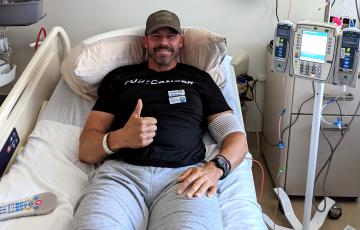Search Results
Nausea and Vomiting
Many cancer treatments can cause nausea and vomiting. Nausea, also called feeling “queasy” or “sick to your stomach,” is that unpleasant feeling you have when you are going to throw up. Vomiting is throwing up what is inside your stomach through the mouth. Nausea and vomiting can happen together, or one can occur without the other. The severity of nausea and vomiting varies among patients. Sometimes these side effects improve as you adjust to treatment, and most side effects go away after treatment ends.
Supportive Care
Treatment given to relieve the symptoms of a disease and the treatment’s side effects is known as supportive care. The goal of supportive care is to improve the patient’s quality of life and to relieve discomfort as much as possible. Supportive care is an important part of MDS treatment.
Mental Health
The term “mental health” includes your emotional and psychological well-being. Your mental health guides how you handle stress, manage relationships and make decisions. Mental health, like physical health, is important to your overall well-being.
Emotions like sadness, anger or stress are normal and healthy responses to difficult life events, such as a cancer diagnosis. However, sometimes persistent feelings of sadness, stress or anxiety can be caused by a mental health disorder. Don't ignore any of these feelings. Talk to your healthcare team about how you are feeling.
Treatment Outcomes
With the current advances in treatment and supportive care, survival rates for myeloma patients have improved significantly in the last decades. It is not unusual for myeloma patients to live for 10 years or longer after diagnosis. Outcomes are influenced by a series of patient-specific factors, including disease stage, chromosome abnormalities, age and presence of other medical problems. Patients should discuss their own potential outcomes with their doctors.
Click here to access myeloma survival statistics.
Treatment
It's important that your doctor is experienced in treating patients with myeloma or works in consultation with a myeloma specialist. This type of specialist is usually called a hematologist oncologist.
Types of Treatment for MyelomaYour treatment may include one or more of the following therapies:
Your Treatment Team
Oncologists and hematologists are specialists who treat persons with leukemia, lymphoma, myeloma, myelodysplastic syndromes and myeloproliferative diseases. Pediatric hematologist oncologists treat children, adolescents and some young adults who have blood cancers. The oncologist or hematologist-oncologist coordinates a treatment and follow-up plan that involves other doctors as well as nurses, social workers, case managers and nutritionists.
Stem Cell Transplantation with High-Dose Chemotherapy
High-dose chemotherapy and stem cell transplantation are important parts of treatment plans for eligible, recently diagnosed myeloma patients.
Imaging Tests
Imaging or radiology tests pass different forms of energy (x-rays, sound waves, radioactive particles or magnetic fields) through your body, creating pictures of the chest, abdomen, head, neck and other parts of the body.
Diagnosis
While certain signs and symptoms may indicate that a person has MF, a series of tests are needed to confirm the diagnosis. It is important to have an accurate diagnosis, as it helps the doctor to:
- Estimate how the disease will progress
- Determine the appropriate treatment
Some of these tests may be repeated both during and after treatment to evaluate the effectiveness of treatment.

Amy
In December 2015, our son, William, started complaining of leg/knee pain. William had always been an active boy, so we figured that he must have just hurt himself doing something physical. After a few days of the pain continuing, my husband thought that maybe it was “growing pains.” We continued to keep an eye on it but weren’t too concerned at this point. By the end of the week, I called our pediatrician for an appointment. William had an exam and bloodwork done. He was also given antibiotics.
NHL Subtypes
More than 60 specific NHL subtypes have been identified and assigned names by the World Health Organization (WHO). NHL subtypes are categorized by the characteristics of the lymphoma cells, including their appearance, the presence of proteins on the surface of the cells and their genetic features. It's important to know your subtype since it plays a large part in determining the type of treatment you'll receive. A hematopathologist, a doctor who specializes in the diagnosis of blood disorders and blood cancers, should review your biopsy specimens.
Chemotherapy
Because of acute lymphoblastic leukemia's (ALL's) rapid growth, most patients need to start chemotherapy soon after diagnosis.
Chemotherapy drugs kill fast-growing cells throughout the body including cancer cells and normal, healthy cells. The damage to normal, healthy cells can cause side effects. Yet, not everyone experiences side effects the same way.
ALL treatment consists of:
Supportive Care and Disease Complications
Supportive (palliative) care for myeloma helps manage the complications of the disease and the adverse side effects of the drugs used for treatment, including:
Kari
I am writing this in 2022, but I never would have believed when acute lymphoblastic leukemia (ALL) struck my daughter in 2013, that it would feel like we were back at step 1.
Be Your Child’s Advocate
Parents may need to educate other family members, friends, school personnel and healthcare providers about long-term and late effects. Here are some steps parents can take:
Chemotherapy and Drug Therapy
The main treatment for active myeloma is systemic drug therapy (meaning the drugs travel through the bloodstream to kill malignant cells). The initial therapy, or “induction therapy,” for myeloma usually includes a combination of targeted agents and/or standard chemotherapy. This therapy is often followed by stem cell transplantation in eligible patients.
Common drugs combinations for people with newly diagnosed myeloma include:

Nicholas
It started with a stiff neck. Then came fatigue and a sore throat. I started feeling full after only a few bites of food. Workouts were getting more difficult to complete. My heart rate was consistently north of 100 just lying in bed. Rationalized. It's maybe strep. Could be mono. I prescribed myself antibiotics and popped ibuprofen. Nothing was working. Reluctantly went to an urgent care after weeks of feeling like this. Bloodwork was done.
Diagnosis
Having the correct diagnosis is important for getting the right treatment. Hodgkin lymphoma (HL) may be difficult to diagnosis. You may want to get a second medical opinion by an experienced hematopathologist before you begin treatment. A hematopathologist is a specialist who studies blood and bone marrow cells and other tissues to help diagnose diseases of the blood, bone marrow and lymph system.
Side Effects
Cancer therapy for non-Hodgkin lymphoma (NHL) can sometimes produce side effects. For most patients, treatment side effects are temporary and go away once therapy ends. For other patients, side effects can be more severe, sometimes requiring hospitalization. Some patients never have side effects.
Before you undergo treatment, talk with your doctor about potential side effects. In recent years, new drugs and other therapies have increased the ability to control side effects.
NHL Staging
Once your doctor confirms an NHL diagnosis, he or she will determine the extent of your disease's progression by staging. Staging helps your doctor predict the disease's progression and develop a treatment plan.
Staging TestsImaging Tests
Your doctor conducts one or more imaging tests along with a physical exam, to evaluate:
Treatment for Aggressive NHL Subtypes
Aggressive non-Hodgkin lymphoma (NHL) progresses rapidly. It makes up about 60 percent of all NHL cases in the United States. Aggressive subtypes include:
Caring for Your Child During Treatment
Preparing the HomeThe following changes to your home may make life easier and safer for you and your child:

